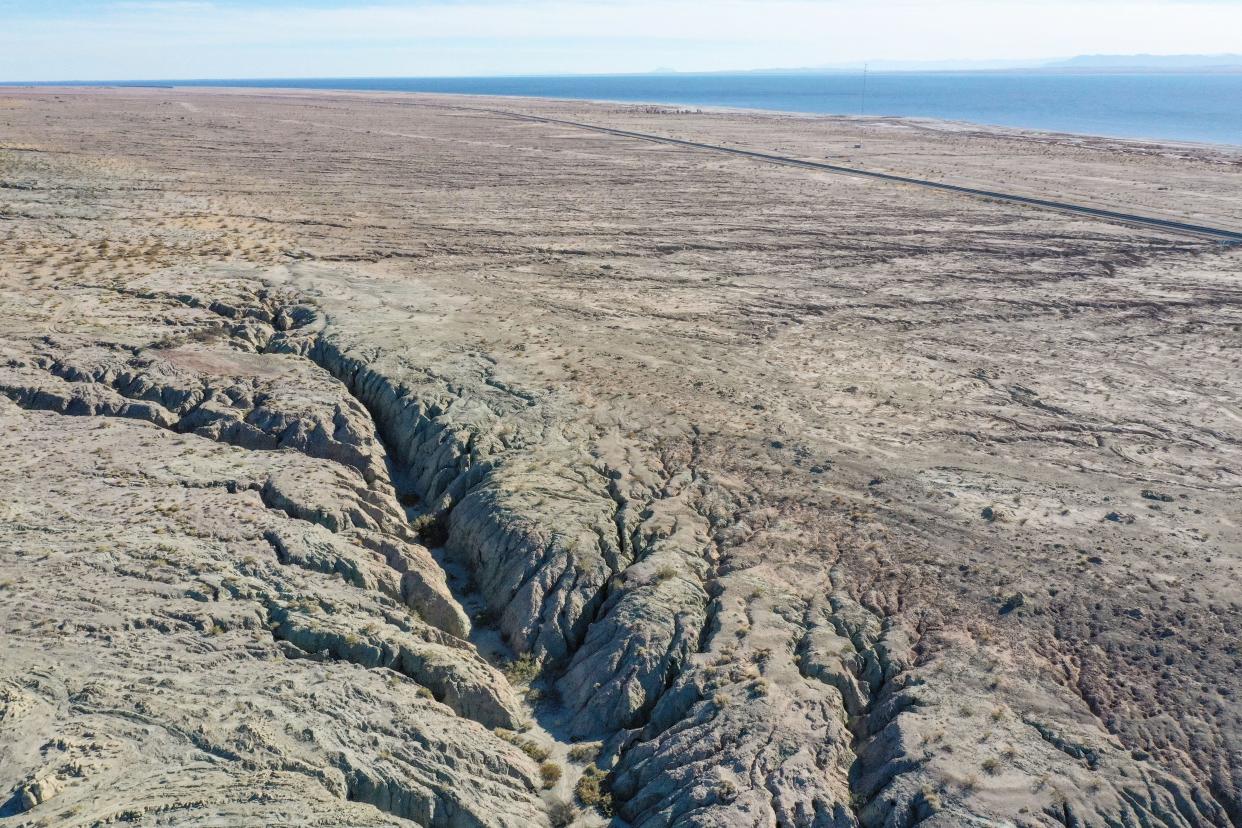What causes an earthquake? We answer questions about tremors you may be shy to ask

The 4.9-magnitude earthquake that occurred northeast of Barstow Monday left Californians across the state feeling the jolt — and with questions about the tremor.
Whether you’re a longtime resident or new to the state, here’s a refresher on the causes of earthquakes, whether prediction is possible, and what to do during one.
Why do earthquakes happen?
The Earth has four layers: the inner core, outer core, mantle, and crust. The crust and top of the mantle make up another area called the "lithosphere," which acts like a skin surrounding the Earth's surface, USA TODAY reported.
The lithosphere, however, is not in one piece and exists like a puzzle or series of fragments, according to the United States Geological Survey. These parts of the lithosphere are not stationary and move slowly. These are called "tectonic plates."
As the tectonic plates move and shift past one another, they occasionally bump or collide. This places stress on the plates' edges. When the stress becomes too great, it creates cracks called "faults." The point where these faults move against each other is called the "fault line."
When there is too much friction between the fault lines, energy is suddenly released, triggering seismic waves that lead to an earthquake.
When is the next earthquake in California?
It is not currently possible to predict an earthquake, though USGS scientists can calculate “the probability that a significant earthquake will occur in a specific area within a certain number of years,” according to USGS.
While earthquake forecasts and probabilities can be determined, USGS says those reports are “comparable to climate probabilities and weather forecasts” and not the same as predictions.
A USGS map of America reveals that portions of California face a greater than 95% chance of experiencing a slight or greater damaging earthquake shaking in 100 years. In other words, a strong earthquake on the Modified Mercalli Intensity Scale that will be “felt by all” will move some heavy furniture and cause slight damage.
When was the last big earthquake in California?
The most recent significant earthquake in the state — either a magnitude of 6.5 or greater or that caused loss of life or more than $200,000 damage — was the 6.4-magnitude earthquake that occurred in the Pacific Ocean near Ferndale in 2022, according to the state department of conservation, which tracks “big” earthquakes in California.
That earthquake struck in the early morning hours multiple miles west of Ferndale on Dec. 20, 2022, USA TODAY reported. It indirectly caused two deaths and damaged homes and roads in Humboldt County.
You can track earthquakes recorded within the last 30 days in America and internationally through USGS’ latest earthquakes map, though USGS cautions it should not be considered a complete list of earthquakes.
Those searching for information about recent earthquakes limited to California and Nevada can visit the Southern California Earthquake Data Center's website.
What have been the biggest earthquakes in recorded California history?
California's largest recorded earthquakes since 1800, ranked by magnitude, according to the California Department of Conservation.
7.9: Jan. 9, 1857 in Fort Tejon Two killed; created 220-mile surface scar
7.8: April 18, 1906 in San Francisco Possibly 3,000 killed; 225,000 displaced
7.4: March 26, 1872 in Owens Valley. 27 killed; three aftershocks of magnitude >6
7.4: Nov. 8, 1980 just west of Eureka Injured 6; $2 million in damage
7.3: July 21, 1952 in Kern County 12 killed; included three magnitude 6-plus aftershocks in five days
7.3: June 28, 1992 in Landers. One killed; 400 injured; $9.1 million in damage
7.2: Jan. 22, 1923 in Mendocino. Damaged homes in several towns
7.2: April 25, 1992 in Cape Mendocino. 356 injuries; $48.3 million in damage
7.1: Nov. 4, 1927 southwest of Lompoc. No major injuries, slight damage in two counties
7.1 : Oct. 16, 1999 in Ludlow. Minimal damage due to remote location
What am I supposed to do during an earthquake?
It depends on where you are at.
Here’s what to do in the following situations, according to Ready.gov:
Turn face down and cover your head and neck with a pillow if you’re in bed.
If you are outside, stay outdoors and away from buildings.
If you are inside, stay. Avoid doorways and do not run outside.
To protect yourself during an earthquake, drop down to your hands and knees and hold onto something sturdy. Cover your head and neck with your arms and crawl underneath a sturdy table or desk to shelter. If that’s not available to you, then crawl next to an interior wall to get away from windows. If you are under a table or desk, hold onto it with one hand so that if it moves, you can move with it.
More: How to prepare for 'the big one' in Coachella Valley
What if I’m driving during an earthquake?
Slow down and pull over as soon as it’s safe, according to the California Highway Patrol. Remain in the vehicle with your seat belt fastened, engine off, and parking brake set. Once the shaking stops, check your vehicle for damage and its occupants for injuries. Only begin driving when it is safe to do so. Once you can start moving again, do so slowly and cautiously, avoiding any areas of the road that appear to be damaged or obstructed, and continue to avoid bridges and ramps.
USA TODAY reporter Olivia Munson contributed to this article.
Paris Barraza is a trending reporter covering California news at The Desert Sun. Reach her at pbarraza@gannett.com. Follow her on Twitter @ParisBarraza.
This article originally appeared on Palm Springs Desert Sun: Earthquake in California: What to do during, why it happens

